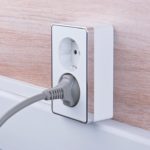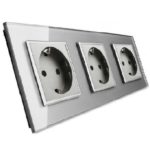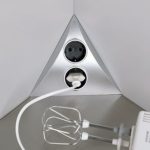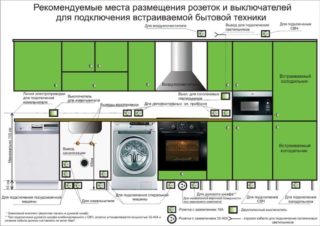Most of the buildings built in the last century had two, maximum three sockets in the kitchen. Previously, this was enough, but now it is extremely insufficient. New appliances, devices, powerful household appliances appeared. Using tees and extension cords will not solve the problem effectively. In addition, such switching methods are prohibited by SNiP. You can get out of a difficult situation by doing electrical repairs with your own hands. To do this, you need to study the types, rules for calculating the required number, location, installation and connection of sockets.
Features of using kitchen sockets
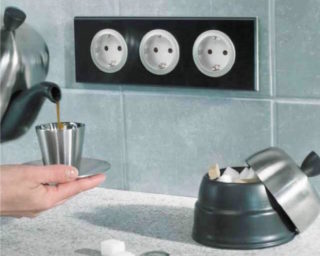
The kitchen is a room where conditions are created that require a special approach to the choice of electrical appliances.
Installation and operation of outlets is carried out taking into account the impact of such factors:
- high humidity, the possibility of condensation on the contacts and terminals;
- the release of fatty fumes that settle inside the pads and deteriorate the quality of the joints;
- danger of spilling and splashing liquids, which could cause a short circuit;
- passage of gas pipes, near which electrical appliances cannot be installed;
- the probability of a breakthrough in heating and water supply;
- a large number of consumers with different power, duration and frequency of operation;
- the need to have a reserve for connecting additional devices.
When choosing the types and options for the location of sockets in the kitchen, you should remember about the aesthetic component. Providing ease of use, power supplies should organically fit into the interior of the room, regardless of its size and design style.
The power of electrical appliances in the kitchen

When planning electrical work in the kitchen, it is necessary to accurately calculate not only the number of sources and their arrangement. An important element of the project is to determine the total power of the lines and sockets separately. It is necessary to take into account the power consumption of kitchen appliances and household appliances.
Average indicators:
- cooking stove - 1000-2500 W;
- dishwasher - 1000-1500 W;
- electric kettle - 1800-2200 W;
- microwave oven - 850-1200 W;
- refrigerator - 400-600 W;
- flow heater - 3000-5000 W;
- hood - 300-500 W;
- oven - 1000-1800 W;
- air conditioner - 900-1500 W;
- TV - 100-300 W;
- washing machine - 1200-2000 W;
- pressure cooker - 400-800 W.
Devices whose power can be ignored can be temporarily connected to the network. These include coffee grinders, mixers, coffee makers, toasters, and table lamps. For such consumers, it is necessary to provide backup slots. Do not forget about the possible need to connect a vacuum cleaner. Some products can generate loads of up to 2000 watts.
You can find out the power of the outlet by the marking on it. It is indicated in volts and amperes. Multiplying these indicators, you can get the desired number (16A x 250V = 4KW). If you need to connect multiple devices, you should purchase 25 A points rated for 6.25 kW. At the same time, there are other criteria that must be taken into account when designing electrical works.
What are the requirements for sockets
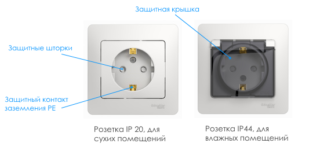
Taking into account the peculiarities of the kitchen, for its arrangement it is necessary to choose electrical appliances that comply with the provisions of SNiP 3.05.06-85.
The following requirements are imposed on sockets in the kitchen:
- Strength. Products should not break or be pulled out of glasses by mechanical impact and pulling out the plug.
- Water resistance. It is necessary to choose such devices, the properties of which will not deteriorate under the influence of dampness.
- High temperature resistant. Housings and inner pads must not melt from heat or hot liquid.
- Durability. Replacing defective instruments can take several hours. All this time the apartment will be de-energized, which creates a lot of inconvenience.
- Reliability. This applies to the quality of the pad fastening, bolts and the elasticity of the terminals. All of them must ensure tight contact.
An important criterion is the appearance of the devices. You should choose sockets that fit organically into the style of the room without spoiling its design.
Varieties of sockets for the kitchen
Depending on the characteristics of the kitchen, you can install the following types of appliances:
- Overhead. The products are easy to install, have a wide range of colors, various shapes and sizes. The main advantage of the structures is that there is no need to drill the walls. They are also easy to connect or replace without dismantling the base or other work. The downside is that the protruding body takes up useful space and makes it difficult to move the equipment closer to the wall.
- Internal. The decision to embed the mounting block in the wall saves a little space. The disadvantage is the need to drill holes in the wall, carry out preliminary work - selection, fastening and fitting of the socket.
- Corner. They are analogs of overhead structures with the difference that they are attached in the corners formed by walls or kitchen sets. This option is good in that the decision to place the sockets in this way makes it possible to find a use for the space, which in most cases is empty.
- Retractable. This solution allows you to hide a unit with multiple entrances under an apron or table top. Products are divided into swivel and retractable. Their use is the most aesthetic and effective solution, especially for Khrushchev, where every centimeter of area and volume counts.
The choice of the type of electric point is made after drawing up a diagram of the arrangement of furniture and household appliances, assessing their skills and financial capabilities.
Layout of sockets in the kitchen
- Lower: refrigerator, stationary stove, washing machine and dishwasher. Some projects include installing electric grinders and water filters under the sink.
- Middle. This includes all equipment and appliances that are installed on and above the countertop - coffee makers, pressure cookers, lights, food processors and microwave ovens.
- Upper. It is equipped with a cooker hood, air conditioning and TV. For the future, you can envisage the likelihood of equipping a kitchen with a sconce or LED strip.
Based on this layout, three independent lines should be made to supply electricity to each tier. Using a powerful 2.5 mm copper cable, all modules can be daisy-chained with minimal material and pre-work costs.
Best accommodation options
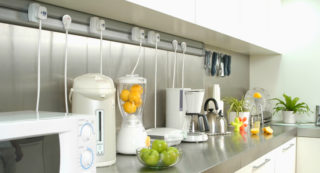
Since most of the electricity consumers are located in the desktop area, it must be used as much as possible.If the plane of the decorative apron will be used, it is necessary to provide that the blocks do not violate the plot of the image applied to the surface.
The next recommendation concerns the decision on how best to distribute the dots on the apron and countertop. It is advisable to place the midline sockets so that they are symmetrical, at the same level and distance from each other. In this case, the bottom line can be made hidden by using the free space between the pedestals and the wall.
For the upper tier, the sockets should be installed so that they are not conspicuous, while observing the electrical safety rules.
In order not to make a mistake in choosing a device layout scheme, you should make several sketches in color and scale on its basis. After comparing them, it remains to choose the most effective and productive option. In this case, it is necessary to take into account the possibility of laying the wiring in an open way. This can be done behind cabinets under the worktop.
Number of sockets
In order not to be mistaken when planning, you need to take into account all the devices that will be connected permanently and add to them half of what is used periodically. Additionally, add 2-3 spare slots.
In all cases, it is better to put more points than will be needed in the future. Constant manipulation of the plugs leads to deterioration of the terminals, is fraught with overturning of household appliances when the devices are disconnected from the network.
Distances and locations

The height of the sockets above the worktop in the kitchen is chosen not only for beauty or convenience. It must be remembered that work is carried out on the working surface with fats, oils and water. Carelessness or accident will result in liquid spills. If the sockets are at the level of the table top, there is a high risk of short circuit and electric shock to a person.
The distance between points and energy consumers should be within the following limits:
- refrigerator - 5-20 cm;
- sockets in the working area and above the table top - 10-30 cm;
- hood - 15-40 cm;
- cooking and oven - 30-50 cm;
- dishwasher - 10-30 cm;
- TV in the kitchen 5-50 cm;
- air conditioner - 10-80 cm.
These parameters are determined by the level of heat generated by the equipment, as well as the likelihood of leaks in emergency situations.
Major mistakes in socket placement
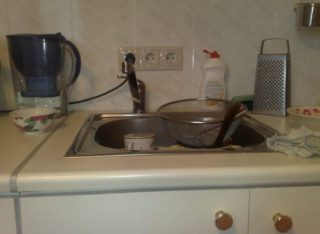
Novice craftsmen make the following mistakes when installing energy sources:
- above the sink, where they can get splashed;
- over the stove, where the rosettes can melt;
- on the back wall of niches, where the device will not enter later;
- near water or drain pipes that might burst;
- running a cable through a gas pipe, which is fraught with fire and explosion.
With competent and thoughtful planning and adherence to the installation rules, you can create a convenient, safe and durable energy supply system in the kitchen that will last for decades.

